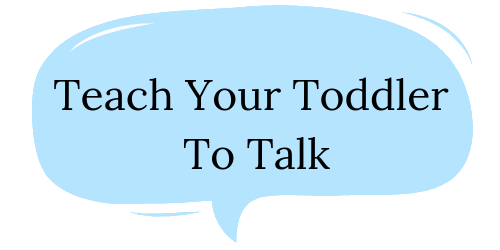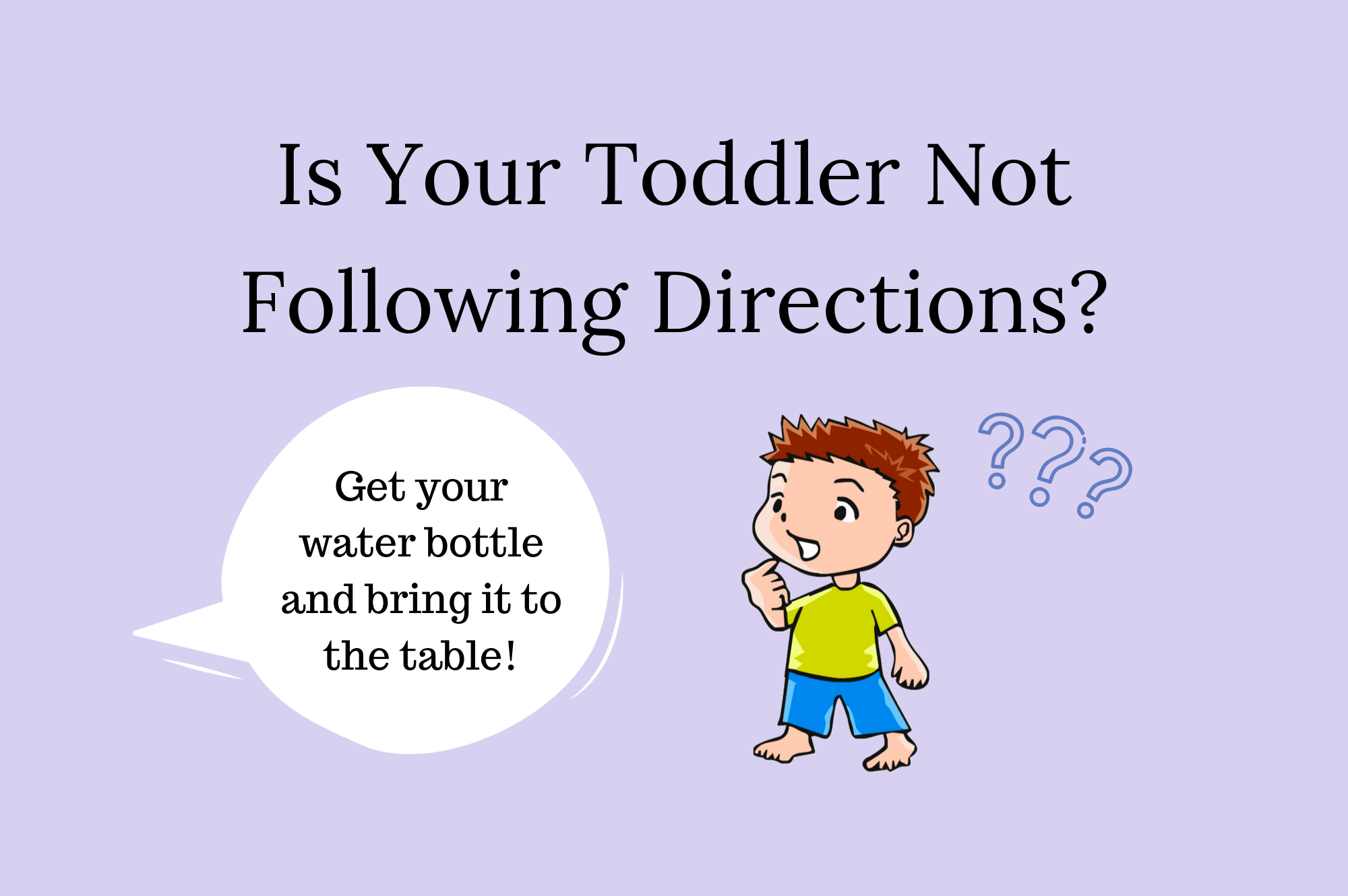Following directions is an important skill for your toddler to learn. It means they are able to listen to what we say, process the meaning of those words, and follow through with the direction. If your toddler is not following directions, there could be a variety of reasons for this.
ATTENTION
For one, difficulties with attention could play a role. Your child may be very active and have difficulty paying attention to what you are saying. If there are many distractions in the room, this can make it even harder to pay attention and follow a direction. We may need to work to improve the toddler’s attention in order to help them understand and follow directions.
PROTESTING/BEHAVIOUR
Toddlers may also not follow a direction because they don’t want to, or they want to be in control. As a parent of a toddler, you know that they often simply don’t want to do what we ask. For example, you tell your child that it’s time to go to bed, and they start protesting. This may be because it’s more fun to stay up and play, they are overtired, or have realized that if they have a tantrum, they will get to stay up longer. There are behaviour strategies you can use to help your child follow directions and make transitions smoother, however that is not my expertise or the focus of this post. For more information about tantrums, check out kidshealth.org
UNDERSTANDING
The focus of today’s article is to determine whether your child is really understanding everything you think they are. Parents know their child the best, and they are often really great at sharing information about the words that they say, the things they like, and how they play. However, it can actually be difficult for parents to tell what their child is truly understanding.
If your child has difficulty following directions, it is worth checking out the receptive language milestones below. Receptive language is the ability to understand words and sentences. Children who have a receptive language delay may have difficulty following directions at home and may not respond appropriately to questions or requests.
If your child’s receptive language is behind what is expected for their age, I strongly recommend seeing a Speech-Language Pathologist or talking to your doctor.
RECEPTIVE LANGUAGE MILESTONES
12 months
- Responds to own name (by 6-12 months)
- Responds to no (by 6-12 months)
- Recognizes family member’s names (by 6-9 months)
- Understand some words when they are accompanied by gestures, like “give me” when you are also holding out your hand
18 months
- Points to several body parts when asked
- Points to pictures in books when named
- Enjoys listening to stories and songs
- Follow simple instructions given without gestures (e.g. “Show me the book” and “Give me the shoe”.
2 years
- Point to familiar actions/activities in pictures (e.g. sleeping, eating)
- Follow directions to put objects “on”, “off” or “in”
- Choose among common objects when asked (e.g. “Find the comb.”, “Where’s the baby?”)
2.5 Years
- Understands early concepts: big/little, in/under (without accompanying gestures)
- Begin to point to objects from a group by their function and parts (e.g. “Which one has wheels?” “Which one can we eat?”)
3 years
- Follows 2 step directions: get your spoon and put it on the table (without accompanying gestures)
- Understands questions such as “Where? What’s that? What’s he doing?”
ASSESSING RECEPTIVE LANGUAGE
In order to determine if your child is understanding these things, you want to first make sure you have their full attention. Then ask them the question or give them the direction. You might say, “Where’s your nose?” If you child touches their nose, it’s pretty obvious they know that one. Try this with other body parts and see how many they know. It is important when you are asking that you don’t use any gestures. So don’t point to your nose, because your child may be just copying you and not really understanding the words.
Try this with other items on the list to determine if your child is understanding what is expected for their age. If you have concerns about how much your child is understanding, keep reading for ways to help.
HOW TO HELP YOUR TODDLER FOLLOW DIRECTIONS
`Here is my step by step process to help your child follow directions
1. Get your toddler’s attention
It is best that there aren’t too many toys out to be distracting. Get down on your child’s level so that you are face to face. If they are super immersed into a toy that they are not noticing you, you should try this with toys that are not as distracting.
2. Start with simple 1-step directions
You want to start with some simple directions for your child to follow. You may ask them to “sit”, “come”, or “give me (an object)”. We want your toddler to be able to follow a variety of 1 step directions before we move on to two step directions. Here are some ideas for 1 step directions:
- sit down, stand up, clean up, put in, wait
- point to…., show me…., give me…., find the…
- clap your hands, stomp your feet, get the ball, push the car, pop the bubble
3. Use gestures
When you are teaching your child to follow directions, this is when you want to use gestures and show them what the direction means. For example, if you are saying “get the ball”, point to the ball while you say it. If you want them to stand up, you stand up yourself to show them what you mean. Matching your words to the gesture or action helps build your child’s understanding of new words and concepts.
4. Help them
If your child still doesn’t follow the direction when you say it and use a gesture, you want to help them follow through with the direction. So if you say “get the ball”, you can bring them over to the ball and help them pick it up. If you say “stand up”, you can take their hands and help them stand up. You always want to give the least amount of assistance needed. If they can do it with just the verbal or gesture prompt, let them do it on their own. But if they need that extra help, that’s when you step in and help them.
5. Use simple language and repetition
Whenever you give the instruction, make sure you are using simple language that’s not too wordy. Directions such as “stand up”, “sit down”, “get the ball” are great because you are modelling correct grammar, but there are only a few words that your child needs to pay attention to. Feel free to repeat the direction several times when you give gestures and while you are helping your child follow it. So I might first say “get the ball”, then “get the ball” + pointing to the ball, and finally “get the ball” and helping the child if needed.
6. Practice in Play and Routines
You can practice following directions in everyday routines. Some easy times to practice is getting dressed to go outside. “Get your shoes”, “get your jacket”, “get your hat”. This is great because it is something you are doing anyway, you might just need to slow down and give yourself an extra few minutes because as you know, it’s much quicker if you do it yourself! But then we’re missing out on valuable teaching opportunities.
Following directions can also be practiced in virtually any play scenario. For example, playing with cars: “put it in the garage”, “put it on top”, “drive it down the ramp”. Playing with babies: “give baby a drink”, “give her a cookie”, “put her to bed”
**It’s important to remember that we want to have balance when we are interacting with our toddler, meaning we’re not going to give our child directions all day long. It’s also important that we follow their lead, because that will help us interact with them in a way that they are interested in. This is merely one way to practice helping your child learn a new skill. We want to keep it fun and light, so your child stays interested in playing with you!
7. Try 2-Step directions
Once your child is able to easily follow a variety of 1-step directions, we can move up to 2-step directions. Some examples of this could be: “get the ball and the train” or “get the book and bring it to me”. The same principles apply: simplify your speech, use gestures, and help them if needed. If 2-step directions are too difficult, step back and continue to work on a variety of 1-step directions, perhaps with some adjectives (get the red train, give me the big ball).
SUMMARY
In conclusion, if you toddler is not following directions, there could be several reasons why. One possible option is that they are having difficulty understanding what is being asked. With the tips in this article, you can determine what your toddler is understanding, and start working with them to increase their understanding of words and help them follow directions.
WANT MORE WAYS TO HELP YOUR TODDLER TALK AND FOLLOW DIRECTIONS?
References
Is your child talking like other children the same age? (n.d.). Retrieved from https://www.tyketalk.com/


